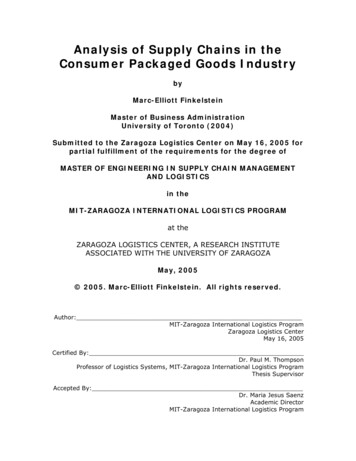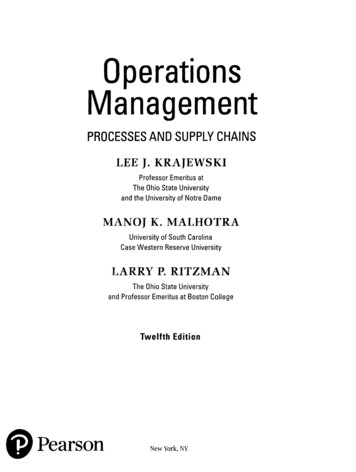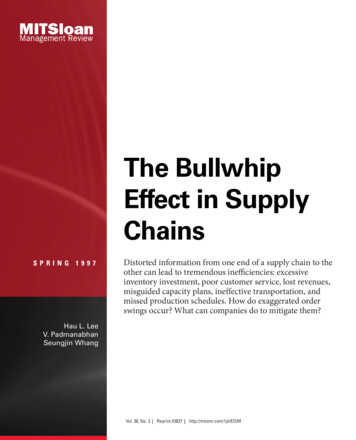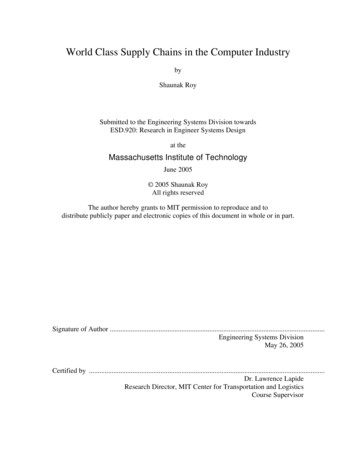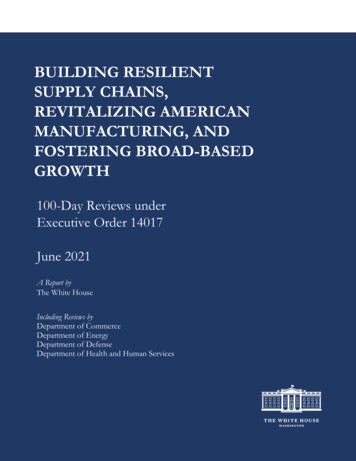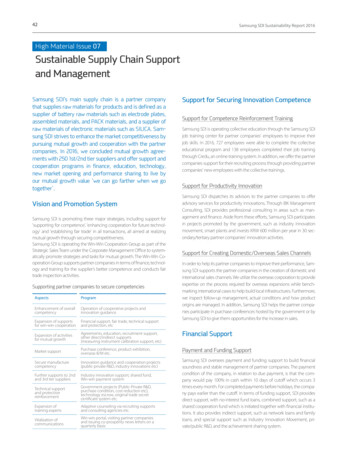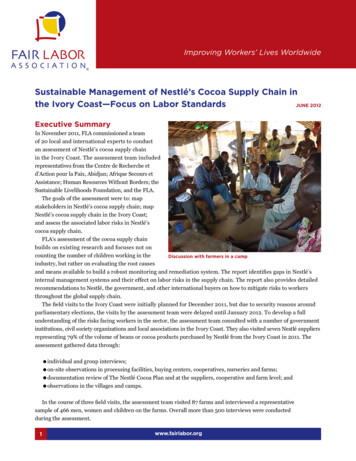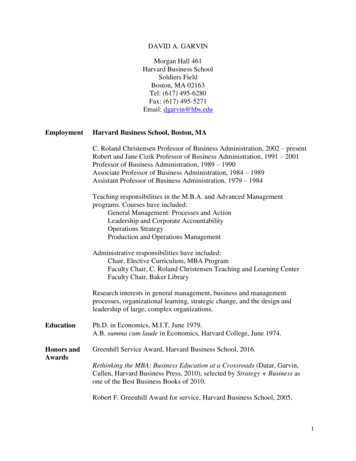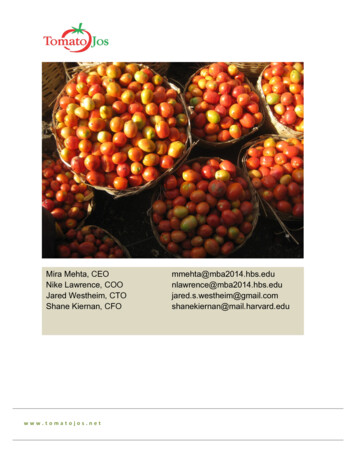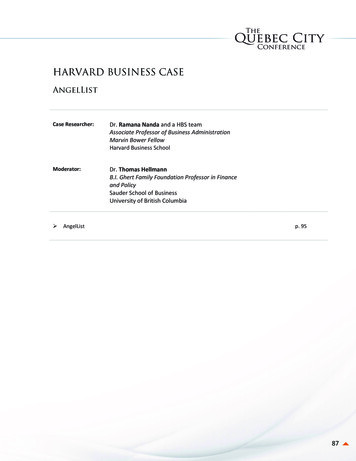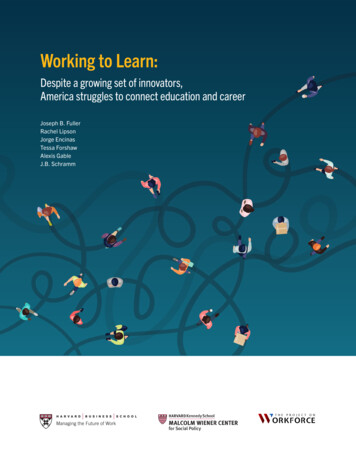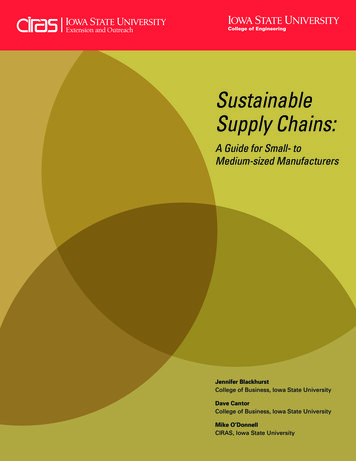
Transcription
Extension and OutreachSustainableSupply Chains:A Guide for Small- toMedium-sized ManufacturersJennifer BlackhurstCollege of Business, Iowa State UniversityDave CantorCollege of Business, Iowa State UniversityMike O’DonnellCIRAS, Iowa State University
The Center for Industrial Research and Service (CIRAS) provides applied research, education, and technical assistance to Iowaindustry through partnerships with Iowa’s universities, community colleges, and government agencies. Assistance is supported inpart by the DoC/NIST Hollings Manufacturing Extension Partnership, the DoD/DLA Procurement Technical Assistance Program,the DoC/EDA University Center Program, and the USDA BioPreferred Program.This report was prepared under awards from the U.S. Department of Commerce, Economic Development Administration and theNational Institute for Standards and Technology, Hollings Manufacturing Extension Partnership.This publication was prepared by the Center for Industrial Research and Service. The statements, findings, conclusions, andrecommendations are those of the author(s) and do not necessarily reflect the views of the Department of Commerce. 2012, Iowa State University Extension. All Rights Reserved.iiSustainable Supply Chains: A Guide for Small- to Medium-sized Manufacturers
Table of ContentsCurrent State of Supply Chain Sustainability: A Benchmarking Report. 1Summary. 1Supply Chain Sustainability: An Introduction . 2Defining Sustainability: Triple Bottom Line Approach. 3The Triple Bottom Line and Stakeholders. 3Examples of Supply Chain Sustainability in Business. 6Lessons from Industry Reports . 6Sustainability within SMEs. 8Synthesizing the Findings. 10Supply Chain Sustainability: Roadmap for Implementation . 11References. 13Appendix A: Examples of Sustainability Initiatives. 15Appendix B: Supply Chain Sustainability Assessment for SMEs. 29Appendix C: Sustainability Standards. 33Sustainable Supply Chains: A Guide for Small- to Medium-sized Manufacturersiii
Current State of Supply Chain Sustainability:A Benchmarking ReportSummaryThe goal of this report is to provide small- to medium-sized enterprises (SMEs) with the tools andknowledge to begin making changes to their business that benefit the triple bottom line—financial, social,and environmental success. This is accomplished through a review of academic research, industry bestpractices, and lessons learned by the authors in working with businesses.Supply chain sustainability is a topic of increasing importance for businesses and can be of particularinterest to SMEs. A recent survey suggests 30% of manufacturers are gaining new profits directly fromsustainability initiatives, showing a clear opportunity for bottom-line results by implementing sustainability.In this report, the concept of supply chain sustainability and its importance in today’s environment isintroduced. The idea of the triple bottom line as the foundation of sustainability is used.This report highlights the importance of supply chain sustainability from a business perspective anddiscusses findings from recent surveys on the benefits and challenges of supply chain sustainability. Itthen focuses on SMEs in particular and how they may use the concept of supply chain sustainability totheir competitive advantage. Finally, a roadmap for developing excellence and expertise in supply chainsustainability is presented and a tool for benchmarking and current state analysis is offered.Sustainable Supply Chains: A Guide for Small- to Medium-sized Manufacturers1
Supply Chain Sustainability: An IntroductionThe issue of sustainability in supply chain management is gaining attention in both academicliterature and industry practice as an area of opportunity. Companies across geographic andindustry boundaries are implementing sustainability initiatives in the supply chain in response topressures from consumers, regions of operation, investors, and even employees. Melnyk, Davis,Spekman, and Sandor (2010) state that supply chains must be designed and managed to delivercertain outcomes—sustainability being one of these outcomes—that are driven by customerneeds. Sustainability may be driven from within the company or may, in part, be the result ofcustomer needs and pressures as well as other supply chain partners such as suppliers and localand federal governments.One of the key aspects of sustainability is theholistic view that is applied in understandingthe total impacts of products and servicesand focusing improvements on areas withthe most impact. This approach encompassesboth the entire life cycle of a product orservice and the entire supply chain of thatservice. Therefore, when businesses addresssustainability, it is usually insufficient tosimply address sustainability initiativeswithin the walls of the company. In order topursue sustainability initiatives with the mostpotential business impact, companies mustlook beyond the borders of their business.Definition of a Supply ChainA supply chain is the material, information,and services, typically crossing several differentorganizations, involved in producing and deliveringa product or service to an end user. Supply chainmanagement is a total systems approach tomanaging the entire flow of information, materials,and services from raw-material suppliers throughfactories and warehouses to the end customer. Infact, some scholars argue that firm survival in themodern business environment is no longer an issueof one firm competing against another firm buthas, instead, become an issue of one supply chaincompeting against another supply chain (Fine 1998).Therefore, throughout this report, supplychain sustainability as the overall approach to implementing sustainability is addressed, includingthe supply base, internal operations, and customer base.This report will Define the scope, importance, and impact of sustainable supply chains; Discuss the importance and opportunities for SMEs to implement sustainable supply chainpractices; and Develop a high-level roadmap for supply chain sustainability.2Sustainable Supply Chains: A Guide for Small- to Medium-sized Manufacturers
Defining Sustainability: Triple Bottom Line ApproachA sustainable supply chain is one that includes measures of profit and loss as well as socialand environmental dimensions (Carter and Rogers 2008; Linton, Klassen, and Jayaraman 2007).Such a conceptualization has been referred to as the triple bottom line—financial, social, andenvironmental performance (Elkington 1994, 1998; Kleindorfer, Singhal, and Wassenhove 2005).The use of triple bottom line is adopted in this report as the definition of sustainability.Carter and Rogers (2008) state that the triple bottom line is the intersection of social,environmental, and financial performance, as shown in Figure 1. Therefore, for a company topursue sustainability they cannot pursue financial or social initiatives in a vacuum. Instead, it isstrongly recommended that supply chainmanagers link environmental, social, andfinancial goals within a broader strategy toEnvironmentalPerformanceensure the business pursues sustainability ratherthan philanthropy.Business success can no longer be measured byonly financial performance, as other aspects arecritical to long-term success. Researchers such asMarkley and Davis (2007) discuss how businessesshould not just be measured by lPerformancefinancial measures, but also by their social/ethicaland environmental performance. These conceptsrevolve around the idea that companies managedand evaluated using the triple bottom line mayhave a better likelihood of long-term success.Figure 1. Sustainability as defined by the triple bottomline (Carter and Rogers 2008)The Triple Bottom Line and StakeholdersRecent research has shown that implementing triple bottom line initiatives is largely in responseto growing pressure on businesses to pay more attention to the environmental and resourceconsequences of their operations. This pressure comes from a variety of groups includingstakeholders, government regulations, nongovernment organizations, and competitors (Dai andBlackhurst 2011; Sarkis 1998). This presents an added complexity in implementing sustainabilitywithin the supply chain. Historically, business initiatives (such as total quality management, leanmanufacturing, and others) require relatively minimal stakeholder input, as these initiatives areprofit motivated. However, the inclusion of the triple bottom line, by definition, brings in additionalstakeholders who focus on the financial, social, and environmental impacts of the business.This effort pays back in terms of profit. Consumers are willing to pay “substantially more” forgoods produced based on triple bottom line, and consumers will also punish producers forSustainable Supply Chains: A Guide for Small- to Medium-sized Manufacturers3
unethically produced goods (Trudel and Cotte 2009). However, the story does not end there. Thenegative impact of unethically produced goods is greater than the positive impact of ethicallyproduced goods. Consumers will, in fact, pay more for ethically produced goods, but if thegoods are unethically produced, consumers will only purchase them at a substantial discount.This highlights not only the benefits of sustainability but the need to market or advertise theseactivities to various stakeholders in the supply chain, including (of course) the end customer.This is supported in academic research as well. For example, Krause, Vachon, and Klassen(2009) state that businesses that emphasize sustainability as a competitive priority will benefit bycommunicating sustainability efforts to customers.Many experts are predicting that sustainable supply chain operations will, in fact, become anintegral part of supply chain strategy and operations. The tools and concepts discussed in thispaper will become part of daily business and tie directly into performance. In a recent DeloitteConsulting report, the tie between sustainable supply chain management and cost savings wasspecifically addressed. In the report, it was stated that while many organizations have traditionallyfocused on their internal operations for cost reduction initiatives, businesses should not ignorethe massive savings opportunities in the supply chain. Leading businesses recognize that thisgoes beyond demanding cost cutting from their suppliers but “re-looking at their supply chainand focusing on reducing use and production of five metrics that are ubiquitous within it—energy,carbon, water, materials and waste.”Applying the triple bottom line concept across the supply chain can lead to significant financialbenefits. The United Nations Global Compact (2010) discusses how sustainability in the supplychain is driven by business needs—specifically, (1) managing risks (risks that are environmental,social, and financial in nature), (2) realizing efficiencies (such as reduction in cost for materials,labor, energy, and transportation), and (3) creating sustainable production (which can meet theneeds of all stakeholders including government, customers, and suppliers). Therefore, there is aneed to integrate sustainability into supply chain strategy and decision-making processes.Recently, a framework for obtaining input from stakeholders in developing a sustainable sourcingstrategy (Figure 2) was developed (Dai and Blackhurst, Forthcoming). This iterative loop couldbe adopted to include all facets of supply chain management. Using a framework such as thiswould not only allow for input but also the sharing of sustainable practices and activities acrossthe supply chain, which could then be used to demonstrate commitment to sustainable practicesacross the entire supply chain.4Sustainable Supply Chains: A Guide for Small- to Medium-sized Manufacturers
“Voice” of StakeholdersCustomer RequirementsDevelop corporate sustainability strategy Economic Environmental Social(focus of this study)OtherStakeholder Requirements(focus of future work)Develop sustainable sourcingstrategy and determinepurchasing competitive prioritiesDetermine requirement forsustainable suppliersAssess and select suppliersMonitor and communicate resultsFigure 2. Sustainable purchasing strategy development process(Dai and Blackhurst, Forthcoming)This above framework is specific to supplier selection processes, but this concept of supply chainsustainability should also be considered beyond simple supplier selection. There are implicationsfor product development, innovation, and even the design of a supply chain that can follow asimilar process.Sustainable Supply Chains: A Guide for Small- to Medium-sized Manufacturers5
Examples
Supply chain management is a total systems approach to managing the entire flow of information, materials, and services from raw-material suppliers through factories and warehouses to the end customer. In fact, some scholars argue that firm survival in the modern business environment is no longer an issue of one firm competing against another firm but has, instead, become an issue of one .
